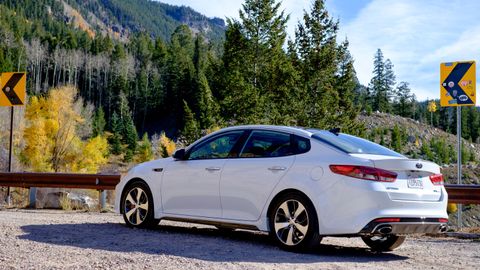Why you can trust TechRadar
The range-topping Optima SX Limited trim offers an integrated Qi wireless charger for phones. The charger is available in the lower cubby, where the USB and 12-volt power plugs are located.
While standard models have two 12-volt power plugs up front, the Qi wireless charger replaces one of the plugs with a light that shows the charging status. I was able to briefly test the integrated charger with my Motorola Nexus 6 and a Samsung Galaxy S6 with success – it works as you'd expect it. The compartment is a little tight with the Nexus 6, so I wouldn't try larger phones.
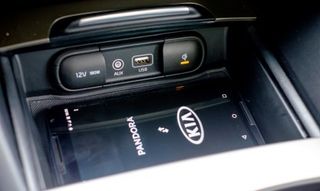
Premium sound
Standard on the SX Limited and optional on the SX is a Harman Kardon-branded premium sound system. The system features 10 total speakers with a 630-watt, 11-channel digital amplifier. For those that are confused by the greater amount of channels to the amount of speakers, the subwoofer in the rear deck is a dual voice coil design and takes two channels to power.
Harman's Clari-Fi and QuantumLogic Surround technologies headline the premium sound system. Clari-Fi claims to rebuild musical details lost in the digital conversion process using a proprietary algorithm developed by Harman.
The sound restoring technology works on all audio sources from USB, Bluetooth to SiriusXM. I spent most of the time listening to SiriusXM in the Optima and the feature does work as advertised.
SiriusXM typically produces low bit-rates, which result in terrible sound quality that sounds very dull. In the Optima, Clari-Fi brings back a bit of warmth to the sound. It's still not as good as a CD or high bitrate MP3, but it makes SiriusXM that much more tolerable in terms of sound quality.
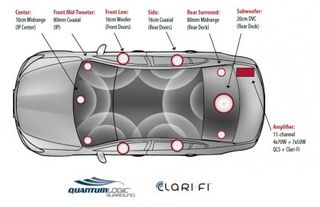
QuantumLogic Surround claims to separate voices and instruments on-the-fly to re-author it into a multi-channel soundstage. The Optima provides an on/off switch for this feature in the audio settings menu. I toggled it on and off with a variety of music and preferred the feature to be on.
Harman's processing keeps the music sounding natural so it's not a major change from the original sound source. The feature raises the sound stage to ear level, so the music is livelier with better staging.
I personally like the Harman Kardon premium sound system. There's a good balance of clarity and mid-bass from the system that lets you hear clear vocals with punchy bass notes. The subwoofer is a little weak, as with most factory systems, but adding bass is a lot easier than replacing all the speakers in the car. It's a good factory system with sound quality that I could live with and not have an itch to upgrade with aftermarket gear.
Driver assists
Kia offers a suite of driver assist technologies that are optional on the SX and standard on the SX Limited to help make your commute or late night driving easier or more annoying, depending on how open you are to the technology. The available features include rear parking sensors, blind spot detection, rear cross traffic alert, emergency braking, forward collision warning, lane departure warning, adaptive headlights, 360-degree camera and – most importantly – adaptive cruise control.
The rear parking sensors, blind spot detection, rear cross traffic alert, forward collision warning and lane departure warning features are all passive functions. These features do not stand to interfere with your driving at all.
The rear parking sensors cause the car to make loud beeps when the rear bumper is getting too close to an object when you're trying to park. Blind spot detection simply sounds off an alert when you put on the turn signal and there's a vehicle in the blind spot – or if another vehicle is accelerating at a higher rate of speed in the lane you're trying to get into.
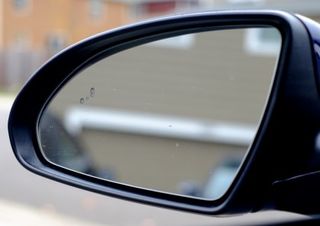
There are two alert processes, including a flashing light located in the side mirrors and an audible alert, so you can see and hear it, assuming you use your side mirrors. The system is conservative when it comes to detecting other vehicles in your blind spot, even if the other vehicle is two car lengths away, but I believe it's better to be safe than sorry.
Rear cross traffic alert is one of those features that's nice to have if you spend a lot of time in busy parking lots. Say you're backing out of a parking spot at the mall, you perform your head checks and don't see any car coming but while backing up, the system detects a child, shopping cart or another vehicle trying to get by you. The system then alerts you, so you can immediately stop and avoid hitting something (or someone) that is now in your path.
Forward collision and lane departure warning are also passive systems. The forward collision warning simply makes loud beeps when it senses the car or object in front of you may cause a collision to encourage braking. Kia does not offer bright flashing red lights that projects onto the windshield like General Motors, Ford, Mercedes-Benz and others. Instead, there's an alert graphic that shows up in the gauge cluster display.
Kia's Autonomous Emergency Braking (AEB) technology takes the forward collision warning system one step further to make it an active safety system. AEB can automatically apply the brakes to stop the car if it detects an imminent collision to lessen the impact if not completely avoid the collision completely.
Adaptive headlights are standard on the SX and SX Limited trim levels, which Kia dubs Dynamic Bending Light (DBL). This is a feature that is very useful if you live in rural environments and drive on windy roads. The feature works by turning the headlamps with your steering wheel so the headlights follow the road.
DBL has its uses, but if your drive consists mostly of well-lit roads and freeways, you most likely won't notice it in action. Nevertheless, it works well with the HID headlights in the Optima.
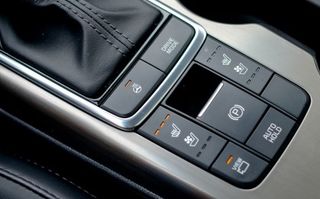
Lastly are two of my favorite features: adaptive cruise control and the 360-degree camera. The first thing you'll notice on vehicles with Kia's smarter cruise control is the switch from a foot-operated parking brake to an electronic parking brake. This small distinction is a big deal when it comes to adaptive cruise control.
Instead of turning off below a certain speed, the Optima's adaptive cruise is a full-speed system that can stop the car completely and hold it without any driver intervention. The beauty of this is that you can completely drive the car in bumper-to-bumper traffic without ever setting your foot on the brake or gas pedal. Simply set a cruise speed, a following distance and let the system speed up or slow down and even stop the car for you.
On other vehicles without the electronic parking brake, adaptive cruise will ask you to step on the brake pedal when it's at a near-stop. The electric parking brake enables the car to automatically apply the brakes at a stop, so you can simply tap the resume toggle or quickly tap of the gas pedal to get going again.
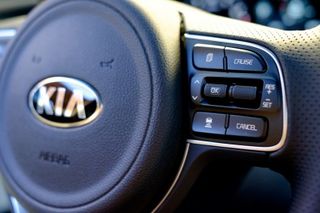
Kia's surround view monitor installs cameras in the front and below the side mirrors to stitch together a 360-degree view of the car. This makes parallel parking or just backing up a lot easier, as you can see the entire car in the infotainment screen.
The feature automatically triggers when the car is put in reverse, but switches to the front camera briefly if you put it in drive and move at a slow rate of speed. You can manually turn on the bird's-eye view of the car, plus the front camera via a button below the shifter at slower speeds to aid parking.
Current page: Audio, driver assists and more
Prev Page Design, interior and infotainment Next Page Performance and living with it
This swirly power bank might be the most sustainable battery pack on the planet

The next HomePod could be more like a soundbar according to this Apple patent – and it hints at fixing the HomePod 2’s biggest issue

Adobe's next big project is an AI that can upscale low-res video to 8x its original quality
